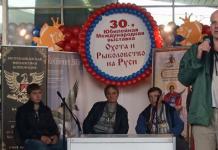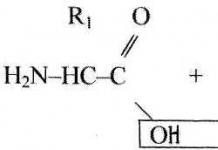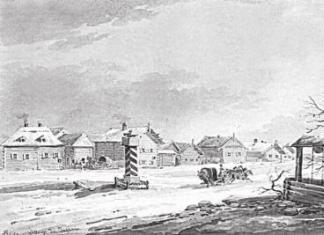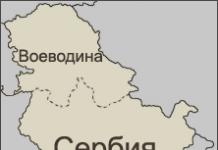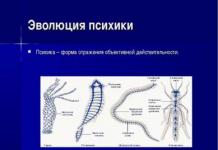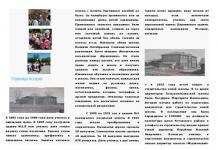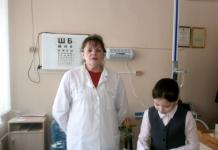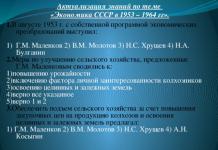Ostrogradsky-Green formula
This formula establishes a connection between the curvilinear integral over a closed contour C and the double integral over the area bounded by this contour.
Definition 1. A domain D is called a simple domain if it can be partitioned into a finite number of domains of the first type and, independently of this, into a finite number of domains of the second type.
Theorem 1. Let the functions P(x,y) and Q(x,y) be defined in a simple domain, which are continuous together with their partial derivatives and
Then the formula holds
where С is a closed contour of the region D.
This is the Ostrogradsky-Green formula.
Conditions for the independence of the curvilinear integral from the path of integration
Definition 1. A closed squarable region D is said to be simply connected if any closed curve l D can be continuously deformed into a point so that all points of this curve would belong to the region D (a region without “holes” - D 1), if such deformation is impossible, then the region is called multiply connected (with “holes” - D 2).
Definition 2. If the value of the curvilinear integral along the curve AB does not depend on the type of the curve connecting the points A and B, then they say that this curvilinear integral does not depend on the integration path:
Theorem 1. Let in a closed simply connected domain D be defined continuous functions P(x,y) and Q(x,y) together with their partial derivatives. Then the following 4 conditions are equivalent (equivalent):
1) curvilinear integral along a closed contour
where C is any closed loop in D;
2) the curvilinear integral over a closed contour does not depend on the path of integration in the domain D, i.e.
3) the differential form P(x,y)dx + Q(x,y)dy is full differential some function F in the domain D, i.e., that there is a function F such that (x, y) D the equality
dF(x,y) = P(x,y)dx + Q(x,y)dy; (3)
4) for all points (x, y) D the following condition will be satisfied:
Let's prove it according to the scheme.
Let us prove that from
Let 1), i.e., be given = 0 by property 2 of §1, which = 0 (by property 1 of §1) .
Let us prove that from
It is given that cr.int. does not depend on the path of integration, but only on the choice of the beginning and end of the path
Consider the function
Let us show that the differential form P(x,y)dx + Q(x,y)dy is the total differential of the function F(x,y), i.e., , what
Let's set a private gain
x F (x, y) = F (x + x, y) -F (x, y) = = == =
(by property 3 of § 1, BB* Oy) = = P (c, y)x (by the mean value theorem, with -const), where x (due to the continuity of the function P). We have obtained formula (5). Formula (6) is obtained similarly. Let us prove that from Given the formula dF(x,y) = P(x,y)dx + Q(x,y)dy. Obviously, = P(x, y). Then By the condition of the theorem, the right parts of equalities (7) and (8) are continuous functions, then by the theorem on the equality of mixed derivatives, the left parts will also be equal, i.e., that Let us prove that out of 41. Let's choose any closed contour from the region D, which limits the region D 1 . The functions P and Q satisfy the Ostrogradsky-Green conditions: By virtue of equality (4) on the left side of (9), the integral is equal to 0, which means that the right side of the equality is equal to Remark 1. Theorem 1. can be formulated as three independent theorems Theorem 1*. In order for the curved int. does not depend on the integration path so that condition (.1) is satisfied, i.e. Theorem 2*. In order for the curved int. does not depend on the integration path so that condition (3) is satisfied: the differential form P(x,y)dx + Q(x,y)dy is the total differential of some function F in the domain D. Theorem 3*. In order for the curved int. does not depend on the integration path so that condition (4) is satisfied: Remark 2. In Theorem 2*, the domain D can also be multiply connected. Communication between dv. Int. In area D and curviline. Int. The Ostrogradsky-Green formula is established for the region L. Let the domain D limit be given on the plane OXY. Curve intersecting with straight parallel cords. Axes at no more than 2 points, i.e., the area D is correct. T1.If f. P(x,y), Q(x,y) is continuous with its multiple derivatives , The area D is then fair forms. L is the boundary of the region D and integration along the curve L is performed in the positive direction.Dovo. T2. If = (2), then the subintegr. The expression P*dx+Q*dy yavl. Full diff. Functions U=U(x,y). P*dx+Q*dy =U(x.y) Satisfies condition (2) can be found using f. Note 1 In order not to confuse the variable integr. X with the upper prednl its designator. Another letter. Deputy 2 as the start point (x0,Y0) usually take the point (0.0) Condition of independence of curvilinear int. 2nd kind from the path integr. Let t. A (X1, Y1), B(X2, Y2),. Let the product points of area D. Points A and B can be connected by different lines. For each of them, Int. will have its own value, if the value is the same for all curves, then the integral does not depend on the type of path int., in this case it is enough to note the initial. Point A (X1, Y1) and endpoint B(X2, Y2). T. In order for cr. Int. Does not depend on the path int. Area D in the cat. F. P(X,Y), Q(X,Y) are continuous together with their derivatives and it is necessary that at each point of the region = Dok-in Cr. Int. 2nd kind does not depend on the path of integration Deputy = hence we get that Pov. Int. 1st kind. His St. and calc. Let at the points pov. S C PL. S space oxyz def. continuous f. f(x,y.z) . Let's break pov. S into n parts Si, PL. EACH PART delta Si, and the diameter Di i=1..m in each part Si choose an arbitrary point Mi from (xi, yi, zi) and make the sum . The sum is called integral for f. f(x,y.z) over the surface S if for integral. The sum has a limit, it is called. Pov integral of the 1st kind from f. f(x,y.z) over the surface S and denoted by = Surface properties Int. 2) Calculation of int of the 1st kind be reduced to the calculation of the 2nd int according to region D, which is the projection of the ep S onto the oxy plane, if the ep s is given by Ur z=z(x, y), then the ep is equal to . If S is given as y=y(x, z), then... Pov int 2nd kind Let a two-sided surface be given, after going around such a surface without crossing its boundary, the direction of the normal to it does not change. One-sided pov: is a Möbius strip. Let φ be defined at a point of the considered two-sided surface S in the space oxyz. F(x,y,z). We divide the ejected side of the surface into parts Si i=1..m and project them onto the cord of the plane. In this case, pl pov, we take with the “+” sign if the upper side of the pov is selected (if the normal forms an acute angle with oz, select with the “-” sign if the lower side of the pov is selected (OBTE ANGLE)). Let us compose an int sum Where - pl pov Si -parts for if it exists and does not depend on the method of dividing the surface into parts and on the choice of points in them, we call int of the 2nd kind from f. f(x,y,z) over s and is denoted: These formulas relate an integral over a figure to some integral over the boundary of the given figure. Let the functions be continuous in the domain DÌ Oxy and on its border G; region D- connected; G is a piecewise smooth curve. Then true Green's formula: here on the left is a curvilinear integral of the first kind, on the right is a double integral; circuit G turns counterclockwise. Let T is a piecewise-smooth bounded two-sided surface with a piecewise-smooth boundary G. If functions P(x,y,z), Q(x,y,z), R(x,y,z) and their first-order partial derivatives are continuous at points of the surface T and borders G, then Stokes formula: on the left is a curvilinear integral of the second kind; on the right - the surface integral of the second kind, taken on the other side of the surface T, which remains on the left when traversing the curve G. If the connected area WÌ Oxyz bounded by a piecewise-smooth, closed surface T, and the functions P(x,y,z), Q(x,y,z), R(x,y,z) and their first-order partial derivatives are continuous at points from W and T, then Ostrogradsky-Gauss formula: on the left, a surface integral of the second kind over the outer side of the surface T; on the right is the triple integral over the area W. Example 1 Calculate the work of force Decision. Work equals Example 2 Calculate Integral Decision. By the Stokes formula (2.23), we reduce the original integral to the surface integral over the circle T: So, considering that , we have: The last integral is the double circle integral DÌ Oxy, on which the circle was projected T; D: . Let's move on to polar coordinates: x=r cosj, y=r sinj, jО, r O. Eventually: Example 3 Find a flow P T pyramids W: Decision. The flow is Example 4 Find a flow P vector field through the full surface T pyramids W: ; (Fig. 2.20), in the direction of the outer normal to the surface. Decision. We apply the Ostrogradsky-Gauss formula (2.24) , where V is the volume of the pyramid. Let's compare with the solution of direct calculation of the flow ( – pyramid faces).

![]() (f.Ostr.-Gr.)
(f.Ostr.-Gr.)![]()
![]() 3) S=s1+s2, Then 4) f1<=f2 , т о 5) 6) 7) Ф. f непрерывна на поверхности S , то на этой поверхности сущ. Точка M(x0,y0,z0) S, такая, что
3) S=s1+s2, Then 4) f1<=f2 , т о 5) 6) 7) Ф. f непрерывна на поверхности S , то на этой поверхности сущ. Точка M(x0,y0,z0) S, такая, что ![]() .
.![]() by definition, the integral will be = the limit of the sum integral. Similarly, int over s
by definition, the integral will be = the limit of the sum integral. Similarly, int over s![]()
![]() , then the general view of the int of the 2nd kind is int where P, Q, R are continuous functions defined at the points of the two-sided surface s. If S is closed pov, then int on the outside is denoted and on the inside. ds. Where ds is the area element of S , and cos , cos cos for example cos is n. The selected side of the pov.
, then the general view of the int of the 2nd kind is int where P, Q, R are continuous functions defined at the points of the two-sided surface s. If S is closed pov, then int on the outside is denoted and on the inside. ds. Where ds is the area element of S , and cos , cos cos for example cos is n. The selected side of the pov. (2.23)
(2.23) (2.24)
(2.24)![]() when going around the point of its application of the circle G: , starting from the axis Ox, clockwise (Fig. 2.18).
when going around the point of its application of the circle G: , starting from the axis Ox, clockwise (Fig. 2.18).
![]() . Let us apply Green's formula (2.22), putting the “-” sign on the right in front of the integral (since the circuit is traversed clockwise) and taking into account that P(x,y)=x-y, Q(x,y)=x+y. We have:
. Let us apply Green's formula (2.22), putting the “-” sign on the right in front of the integral (since the circuit is traversed clockwise) and taking into account that P(x,y)=x-y, Q(x,y)=x+y. We have:
,
where S D- area of a circle D: , equal to . As a result: - the desired work of the force.![]() , if G there is a circle in the plane z=2, bypassed counterclockwise.
, if G there is a circle in the plane z=2, bypassed counterclockwise.
T: 
.![]() (Fig. 2.19) in the direction of the outer normal to the surface.
(Fig. 2.19) in the direction of the outer normal to the surface.
![]() . Applying the Ostrogradsky-Gauss formula (2.24), we reduce the problem to the calculation of the triple integral over the figure W-pyramid:
. Applying the Ostrogradsky-Gauss formula (2.24), we reduce the problem to the calculation of the triple integral over the figure W-pyramid:

 ,
,
since the projection of the faces onto the plane Oxy has zero area (Fig. 2.21),






